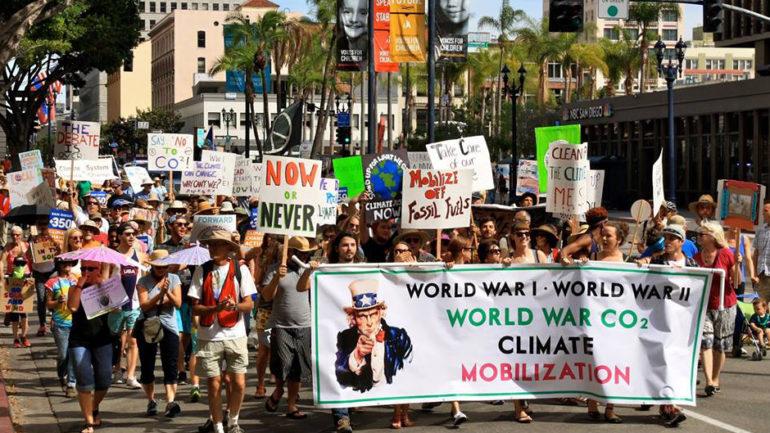Marshall Herskovitz: Why the Climate Crisis Needs Movie Marketing-Style Muscle
By Marshall Herskovitz
LOS ANGELES (Variety.com) –
I’ve lived inside the climate-communications conundrum for 20 years, working with scientists, academics and activists to find ways to convince Americans that something they couldn’t see or feel was nevertheless a looming catastrophe worth upending their lives to fight.
Now the climate crisis is undeniable, and we are finally seeing the beginnings of concerted action. Too late. And not enough. And we are beset by different naysayers now, including Jonathan Franzen’s defeatist article in the New Yorker, “What If We Stopped Pretending?” and Michael Moore’s new film “Planet of the Humans,” in which the filmmakers are shocked, shocked to discover that renewable energy isn’t what it’s supposed to be, and has already been co-opted by the very interests – big oil, big money, the Kochs – it was meant to fight.
Before we give up, let’s look back at the moment in history most analogous to the battle we face: World War II. But not the World War II of smiling GIs entering Paris and Liberty ships sliding into the water at the rate of one per week. No, let’s look at the World War II of early 1942, when America was utterly unprepared for war, when Britain was on the verge of collapse, and we found ourselves outgunned, outmanned and out-strategized by the Axis powers. In early ’42, we weren’t just losing the war; there was no known path to victory. And we continued to lose for another 18 months, until the remarkable engine of American innovation and production began to prevail.
So we’ve been here before. And yes, the climate fight will be damned hard. We can either be cowards and give up, or we can get to work like those who came before us.
Three great changes are necessary before we can win this battle:
First, we must develop feasible mass storage of energy. We’re getting there, but this is the time for a Manhattan Project-type initiative to make it happen.
Second, we must completely redefine how we create and distribute energy. For 120 years, it’s been the job of public utilities around the country, regulated monopolies expected to make a profit. But utilities stop profiting when too many people create their own energy, so in spite of cool PR campaigns, utilities are the major stumbling block to wide-scale renewable energy.
Therefore, we must do the modern version of closing automobile factories and turning them over to making tanks: We must transform the economic model of utilities from creating energy into storing and distributing energy others create. This will mean huge government spending — remaking our entire energy infrastructure — but as Eisenhower proved with the highway system in the ’50s, large-scale infrastructure projects can grow the economy more than they cost.
And the way that will happen — the third great change — is that once the utilities are realigned, Americans will line up to spend trillions of their own dollars moving to renewable energy. Why? Because decentralized energy will be the great wealth-builder of the 21st century. Think of the automobile and computer revolutions: In pure dollars, both cost trillions, yet the return on those costs has been so huge as to be uncountable. The same will be true of energy. There are more than 100 million buildings in America. Over the next 10 years, the owners of those buildings will discover that they can save money — immediately — by installing solar or participating in community wind or solar.
While naysayers bemoan the lack of usable desert land in California for solar farms, ordinary citizens will be covering the roof of every church, school and factory with solar panels, blanketing the miles of roofs we see in the Inland Empire when we fly into Los Angeles, creating a future where power is generated anywhere and everywhere, paying dividends to everyone who participates. In the ’60s, it was “Power to the people.” In the 21st century, it will be power from the people.
Virtually none of this has been communicated to the American population. Social scientists can debate why we seem more timid today than our grandparents were in 1942, but it’s hard to be bold when you don’t have a vision of where you’re going. In Hollywood, we live or die by marketing: We make a film no one’s ever heard of, spend $40 million in sophisticated messaging, and three weeks later — voilà — public awareness is at 90%. These techniques have never been applied to the climate crisis, and without this kind of large-scale communications campaign, Americans simply have no way of envisioning a future they can aspire to.
That future need not be one of privation and disaster. The Energy Revolution will create millions of American jobs in manufacturing and installation, lower the cost of living for everyone, make us truly energy independent and — because energy will be decentralized — leave us better equipped to handle whatever climate disruptions can’t be stopped.
If we can communicate that vision, I believe Americans will rise to the challenge like they always have. No one considered letting the Axis win. Let’s not consider letting the naysayers win now.
Marshall Herskovitz, producer of “Nashville” and “Thirtysomething,” has been a climate activist for 20 years. In 2007, he co-founded 1Sky, an activist organization that later merged with 350.org. For the past two years, Herskovitz has been an adviser to The Climate Mobilization , which advocates for the policies he urged on Congress 14 years ago when he called for an immediate World War II-style national mobilization.

